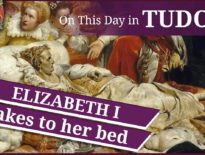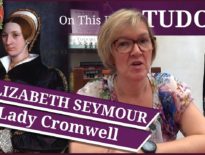On this day in Tudor history, 20th March 1544, Cuthbert Mayne (Main/Maine) or St Cuthbert Mayne, Roman Catholic priest and martyr, was baptised in Youlston in North Devon.
Cuthbert Mayne has gone down in history as the first seminary priest to be martyred. He was hanged, drawn and quartered at Launceston on 30th November 1577, in the reign of Queen Elizabeth I.
Let me tell you a bit more about this Elizabethan martyr.
Also on this day in Tudor history, 20th March 1549, Thomas Seymour, 1st Baron of Sudeley, was executed by beheading on Tower Hill. Find out more about his sticky end in last year's video:
Also on this day in history:
- 1469 – Birth of Cecily, Viscountess Welles and princess, also known as Cecily of York, third daughter of Edward IV and Elizabeth Woodville. She was born at Westminster Palace. A marriage alliance with Scotland was made in 1473 promising Cecily to James, the infant son of James III, but Cecily was still unmarried at her father's death in 1483. Her uncle, Richard III, arranged Cecily's marriage to Ralph Scrope of Upsall, but Henry VII dissolved the marriage in 1486 and she married John Welles, Viscount Welles, the King's half-uncle. After Welles' death in 1499, Cecily went on to marry Thomas Kyme of Friskney. Cecily died in 1507.
- 1555 – Burial of John Russell, Earl of Bedford, courtier and magnate, at Chenies, following his death on 14th March. It was a lavish funeral with three hundred horses, all in black trappings.
- 1560 – Birth of Sir Edward Hoby, scholar, theologian, politician and diplomat, at Bisham in Berkshire. He was the eldest son of Sir Thomas Hoby and Elizabeth (née Cooke), daughter of Sir Anthony Cooke. Elizabeth I favoured Hoby and used him on a number of secret missions.
- 1572 - Death of Mary Bassett (née Roper), translator and granddaughter of Sir Thomas More. Her education was praised by Roger Ascham and Nicholas Harpsfield, and she presented Mary I with a copy of five books of Eusebius's “Ecclesiastical History” which she had translated from Greek into English.
Transcript:
20 March
On this day in Tudor history, 20th March 1544, Cuthbert Mayne or St Cuthbert Mayne, Roman Catholic priest and martyr, was baptised on the Feast of St Cuthbert in Youlston in North Devon.
Cuthbert Mayne has gone down in history as the first seminary priest to be martyred. He was hanged, drawn and quartered at Launceston on 30th November 1577.
Let me tell you a bit more about this man...
• Cuthbert Mayne was born in 1544 and was the son of farmer William Mayne.
• Cuthbert was educted at Barnstaple Grammar School. His father's boss, Sir John Chichester, acted as Cuthbert's patron and in 1561, when Cuthbert was just 17, Chichester got him installed as rector of Hutshaw in Devon. In 1565, he went to St Alban Hall, Oxford, and in 1566 he graduated BA. He then became a chaplain at St John's College and obtained his MA in 1570.
• During his time at St John’s, Gregory Martin, Edmund Campion and others warned him of the “evil state he stood in” and encouraged him to convert to the Roman Catholic faith and to travel to Douai. One of their letters to Cuthbert was seen by the Bishop of London, who sent men to Oxford in search of Cuthbert, but Cuthbert had managed to feel to Douai already and there was admitted to the English College, the Jesuit seminary college.
• He was ordained as a priest there in 1575 and obtained his Bachelor in Theology on 1576.
• Cuthbert returned to England in 1576 and became chaplain and steward to Francis Tregian, a recusant gentleman of Golden Manor, near Probus in Cornwall. He celebrated mass at several of Tregian's family estates in Cornwall, but in June 1577, after the Bishop of Exeter and Sheriff of Cornwall had decided to crack down on Catholics in Cornwall, Golden Manor was surrounded by a number of Justices of the Peace and a hundred armed men. They were intent on searching the property on the pretext that they had heard that a Mr Bourne, who had committed a crime in London, had fled to Cornwall and was holed up in the house. After being threatened by the sheriff with a dagger, Tregian allowed the men into his house and they went straight to Cuthbert's room. Cuthbert, who was wearing a prohibited wax Agnus Dei at the time, was arrested, and his papers seized and sent to the bishop. By the way, a wax Agnus Dei was a wax disc usually made from the previous year’s Easter candles and imprinted with a lamb, the lamb of God, on one side and figures of saints on the other.
• Cuthbert was paraded through several Cornish villages on his way to his prison at Launceston Castle, where he was imprisoned for 3 months before he was tried at the Michaelmas Assizes. The charges against him included him traitorously getting hold of a papal bull and publishing it at Golden Manor, defending the authority of the Pope, purchasing a number of Agnus Dei and giving them to people, and celebrating the Catholic mass. Cuthbert was found guilty of treason and sentenced to be hanged, drawn and quartered, while his master, Francis Tregian, had his property seized and was sentenced to life imprisonment. In his book Memoirs of Missionary Priests, Bishop Richard Challoner, notes that "there were no sufficient proofs of any of these heads of the indictments" and that the bull was simply "a printed copy of the grant of the jubilee of the past year" and had not been procured by Cuthbert.
• On 29th November 1577, Cuthbert was allegedly offered mercy if he would renounce his Catholic faith, which he refused to do. He also refused to name any other Catholic recusants. He was also asked to swear on the Bible that Queen Elizabeth I was the Supreme Head of the Church in England: “Upon this he took the Bible into his hands, made the sign of the cross upon it, kissed it, and said, “The queen neither ever was, nor is, nor ever shall be, the head of the church of England””.
• On 30th November 1577 Cuthbert was drawn on a hurdle to the market place of Launceston for his execution. Bishop Challoner drew on an account published in 1582 and a Latin Manuscript from Douai in his account of Cuthbert's life and execution. Here is the account of his execution:
“When he came to the place of execution, which was the market-place of the town, where they had on purpose erected a gibbet of unusual height, being taken off the sledge, he kneeled down and prayed: when he was on the ladder, and the rope about his neck, he would have spoken to the people, but the justices would not suffer him, but bid him say his prayers, which he did very devoutly. And as the hangman was about to turn the ladder, one of the justices spoke to him in this manner: 'Now villain and traitor, thou knowest that thou shalt die, and therefore tell us whether Mr Tregian and Sir John Arundel did know of these things which thou art condemned for: and also what thou dost know by them?' Mr Main answered him very mildly: 'I know nothing of Mr Tregian and Sir John Arundel, but that they are good and godly gentlemen; and as for the things I am condemned for, they were only known to me, and to no other' - Then he was cast off the ladder saying 'in manus tuas', etc. and knocking his breast.
Some of the gentlemen would have had him cut down strait away, that they might have had him quartered alive; but the sheriff's deputy would not, but let him hang till he was dead. The Latin manuscript says, "he was, indeed, cut down alive, but falling from the beam, which was of an unusual height, with his head upon the side of the scaffold, on which he was to be quartered, he was by that means almost quite killed; and therefore but little sensible of the ensuing butchery. His quarters were disposed of, one to Bodwin, one to Tregny, one to Barnstable, and the fourth to remain at Launceston castle: his head was set upon a pole at Wadebridge, a noted high-way. The hangman, who embrued his hands in his innocent blood, in less than a month's time became mad, and soon after miserably expired. And it is particularly remarked, that not one of those whom Mr. Maine reconciled to the church, could ever be induced to renounce the catholic truth, which they had learned from so good a master.”
• Cuthbert was canonized on 15th October 1970 by Pope Paul VI as one of the forty martyrs of England and Wales. St Cuthbert Mayne's feast day is celebrated on 30th November.



The future Saint Philip Howard witnessed the execution of Saint Cuthbert Mayne and converted.
What a cutie! Thanks, Claire! Michelle t